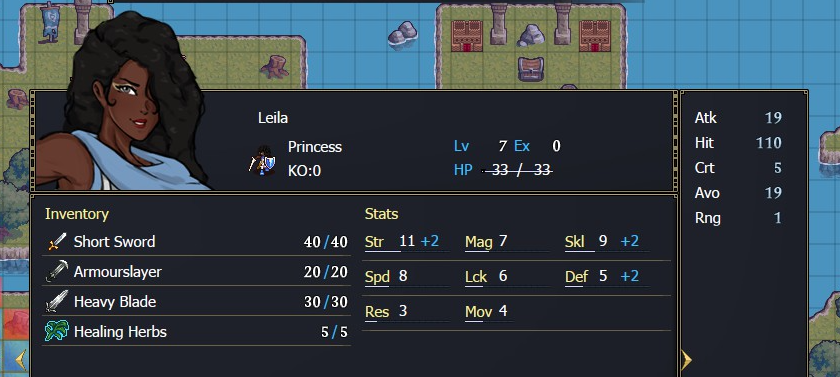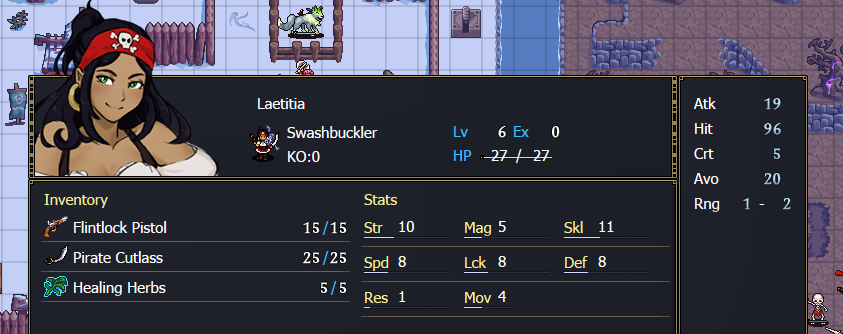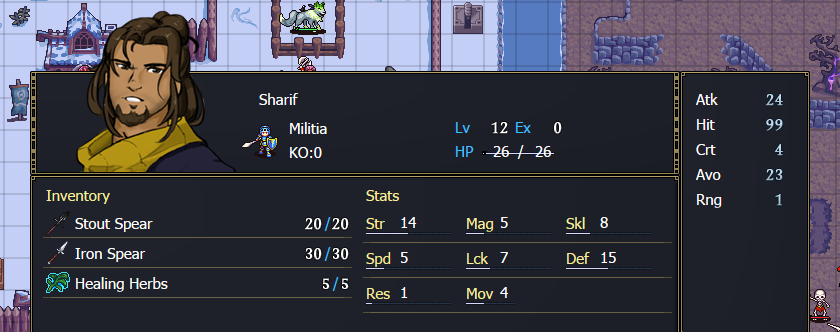
Weapons are the primary means by which units fight on the battlefield: if they’re striking an enemy in some form, they’re almost always using their equipped weapon as the basis for their attacks. To ensure that terminology is consistent, and that references to weapon types and character abilities makes sense, we’ll be going over the weapons in Gales of Nayeli today!

Basics of Weapons
As characters use weapons of a specific type more, they will gain Weapon Experience (WEXP), increasing their proficiency with those types of weapons. As a character’s WEXP raises, they gain the ability to equip higher-quality and more specialized weapons in that class.
When weapons are used to attack, they lose durability. Each individual attack takes one durability. Combat Arts will use additional durability. When a weapon’s durability reaches zero, the weapon will break, and have significantly reduced performance until repaired with a Grindstone.
Most weapons have additional effects, and very few have nothing more than their Might (MT), Hit, and Critical Hit Chance: however, before we discuss more specific weapon interactions and effectiveness, it’s important to go through the weapon types and their general attributes. These are, as follows:
Swords: Light and accurate, but deal modest damage at best.
Greatswords: Deal more damage than regular swords, but are less accurate and heavier, and cannot make follow-ups. Share WEXP with regular swords.
Axes: Stronger than swords, but less accurate.
Lances: Balanced damage and accuracy in comparison to swords and axes.
Daggers: Low damage but very high accuracy, able to hit twice consecutively before follow-up attacks.
Melee: Variable characteristics that vary depending on type and user, typically equipped by monsters or brawlers.
Gauntlets: Typically hit twice consecutively. Shares WEXP with Melee weapon type.
Talons: Accurate, but lower damage compared to other Unarmed types. Exclusive to Harpies, and the only Unarmed weapon they can use. Shares WEXP with Melee weapon type.
Bows: Typically have two to three range. Deal effective damage against Flying units.
Firearms: Variable range. Often gain extra damage modifiers or unique mechanics.
Staves: A unique weapon type that can heal or buff allies or debuff enemies, but cannot be used to enter combat. Healing potency is affected by the quality of the staff, as well as the user’s Magic stat.
These are the basic weapon types, and their usual characteristics, that the majority of enemies and playable units will rely on.

Tomes and Trinkets
When a character casts an offensive spell, their “equipped weapon” is considered to be a “Tome” or a “Trinket” bearing that spell’s name. These are considered Magical Weapons.
The three types of Magical Weapons are:
Elemental: All spells that deal Fire, Thunder, Ice, Wind, or Earth damage are considered to be Elemental Tome weapons.
Dark: All spells that deal Dark damage are considered to be Dark Tome or Trinket weapons.
Light: All spells that deal Light damage are considered to be Light Tome weapons.
Magical Weapons generally factor the user’s Magic stat against the opponent’s appropriate elemental resistance and Resistance stat, and typically cannot perform follow-up attacks.

Effectiveness
Now that the foundations are out of the way, we can get into some of the more specific details embedded in the use of weapons, including their interactions and the concept of effective damage.
When an attack is effective against a target, the attacker’s Attack, including STR or MAG and Weapon MT, is increased by fifty percent when damage calculations begin. This damage is calculated before any applicable mitigations from the target’s Defense, Resistance, or Elemental Resistance.
Effective damage comes into play when a unit has a specific effective weapon and targets an enemy whose class, or other characteristics make them vulnerable to that weapon. However, effective damage can also be tied to particular Combat Arts.

Weapon Interactions
Exploiting such vulnerabilities is a common tactic in SRPGs, but Gales of Nayeli does not have a traditional weapon triangle, wherein all weapons of a specific type are vulnerable to weapons of another type and advantageous against weapons of a third type.
There are, however, specific weapons that can replicate this dynamic, albeit in a different fashion. Some examples include the Deft Sword, which gives the wielder bonus Avoid against axe attacks; the Stout Lance, which prevents follow-up attacks and guarantees follow-ups against sword users; and the Bearded Axe, which increases Critical Hit Chance against lance users.
Having access to multiple weapon types is still very valuable, as some types of effective weaponry, or some specialized weapon interactions, are only available to specific weapon types. These are intended to allow for some specific weapons to create opportunities for weapon-class based counterplay, but without rigidly enforcing a rock-paper-scissors dynamic that controls all cross-weapon interactions.
There’s much more to discuss on the topic, such as specific bonuses and elementally-imbued armaments, but given that this is already a very mechanical and information-laden update, we’ll spare you those details for now. We hope that this has equipped you with some of the knowledge you’ll need to best make use of the great variety of weapons to be found in Gales of Nayeli!
See you tomorrow with more daily updates leading up to the Kickstarter Campaign!
David
